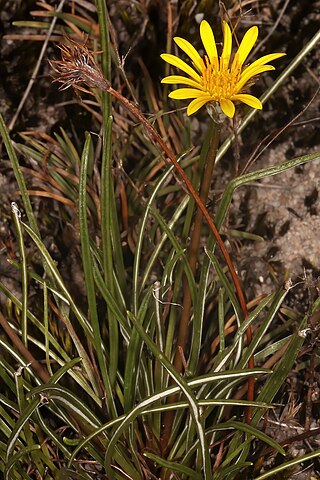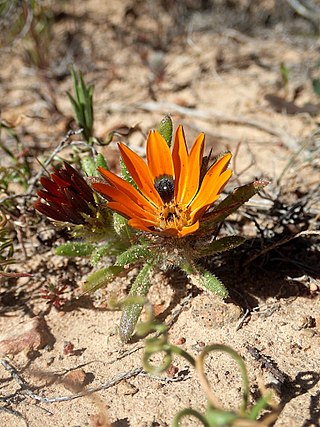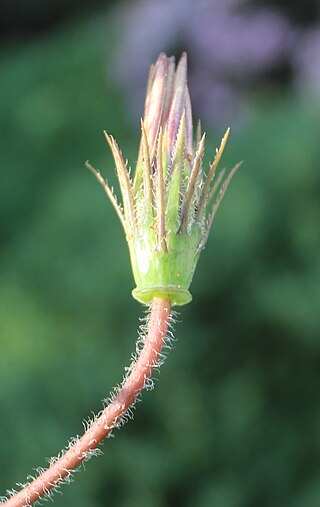
Gazania is a genus of flowering plants in the family Asteraceae, native to Southern Africa.

Felicia aethiopica is a low shrublet of up to about 50 cm high that is assigned to the family Asteraceae. It has rigid, leathery, inverted egg-shaped leaves, with only the lowest pair set oppositely. It has flower heads with an involucre of about 8 mm in diameter with bracts that each contain three resin ducts, and have one whorl of twelve to fourteen ray florets with about 11 mm long and 1½ mm wide blue straps surrounding many yellow disc florets. The plant is called wild aster or dwarf Felicia in English, and wilde-aster or bloublombossie in Afrikaans. Flowering occurs year-round. Wild aster can be found in the Western and Eastern Cape provinces of South Africa.

Gazania linearis is a species of flowering plant in the family Asteraceae, with thin linear leaves, native to South Africa.

Gazania rigens, sometimes called treasure flower, is a species of flowering plant in the family Asteraceae, native to coastal areas of southern Africa. It is naturalised elsewhere and is widely cultivated as an ornamental plant.

Felicia filifolia is a Southern African member of the family Asteraceae. It is a hardy, sprawling shrub growing to about 1 metre tall. Leaves are narrow and clustered along the twigs. When blooming it is densely covered in flowerheads with ray florets that are pink-mauve to white and disc florets that are yellow. In the wild, flowers can be found August to December.

Gorteria is a genus of small annual herbaceous plants or shrubs, with 8 known species, that is assigned to the daisy family. Like in almost all Asteraceae, the individual flowers are 5-merous, small and clustered in typical heads, and are surrounded by an involucre, consisting of in this case several whorls of bracts, which are merged at their base. In Gorteria, the centre of the head is taken by relatively few bisexual and sometimes also male, yellow to orange disc florets, and is surrounded by one complete whorl of 5–14 infertile cream to dark orange ray florets, sometimes with a few ray florets nearer to the centre. None, some or all of them may have darker spots at their base. The fruits remain attached to their common base when ripe, and it is the entire head that breaks free from the plant. One or few seeds germinate inside the flower head which can be found at the foot of plants during their first year. The species flower between August and October, except for G. warmbadica that blooms mostly in May and June. The species of the genus Gorteria can be found in Namibia and South Africa.

Brachylaena rotundata is an occasionally deciduous Southern African shrub or small tree growing to some 8m in height and of the family Asteraceae. It occurs in eastern Botswana, Transvaal, Mozambique, Zambia and Zimbabwe, growing in open woodland, on rocky koppies and slopes, and on stream banks. Kew accepts Brachylaena rotundata S. Moore as a species while 'Flora of Mozambique' treats it as a variety of Brachylaena discolor DC. It bears attractive foliage, green on the upper surface and silver-grey on the lower, leaves turning slightly reddish in autumn.
Leaves with petioles from 2 mm to 7 mm. long, lamina 4–15 x 2.5–6 cm., larger on coppice shoots, broadly oblanceolate or elliptic, obtuse to rounded at the apex, cuneate or rounded base, entire, occasionally coarsely dentate near the apex; upper surface araneous when young, or glabrescent; lower surface greyish tomentellous with prominent veins. Capitula sometimes preceding the leaves, young synflorescences with buds in axillary and terminal spikes, mature synflorescences with numerous capitula in dense terminal panicles 4–40 cm. long, or in short raceme-like panicles in axils of old leaves. Involucres cyathiform to obconic. Phyllaries minutely glandular outside, subobtuse, margins ciliolate, the outer phyllaries from c. 1 mm. long and ovate, the inner to c. 5 mm. long becoming lorate-lanceolate, narrowly obtuse or blunt at the apex; the outermost 5–8 series decreasing in size and extending down to the base of the capitulum stalk. Male flowers: corollas dull-yellow, 3–5 mm. long, lobes c. 1.5 mm. long and ± recurved; pappus uniseriate, setae 3–4 mm. long, subplumose, the seta barbs exceeding the seta axis in width. Female flowers: corollas dull-yellow, 3–5 mm. long, filiform, lobes erect up to c. 0.5 mm. long; achenes c. 4 mm. long, subcylindric-fusiform, narrowly c. 8-ribbed, pubescent; pappus 2-several-seriate, setae 4–5 mm. long, ± terete or flattened, seta barbs ± equalling the seta axis in width.""

Gorteria diffusa is a highly variable, small annual herbaceous plant or rarely a shrublet that is assigned to the daisy family. Like in almost all Asteraceae, the individual flowers are 5-merous, small and clustered in typical heads, and are surrounded by an involucre, consisting of in this case several whorls of bracts, which are merged at their base. In G. diffusa, the centre of the head is taken by relatively few male and bisexual yellow to orange disc florets, and is surrounded by one complete whorl of 5–14 infertile cream to dark orange ray florets, sometimes with a few ray florets nearer to the centre. None, some or all of them may have darker spots at their base. The fruits remain attached to their common base when ripe, and it is the entire head that breaks free from the plant. One or few seeds germinate inside the flower head which can be found at the foot of plants during their first year. The species flowers between August and October. It is called beetle daisy in English and katoog in Afrikaans. It can be found in Namibia and South Africa.

Vexatorella obtusata is an evergreen shrub, with narrow, leathery leaves and about 2 cm big, globular flowerheads consisting of well scented, creamy pink flowers, from which a long style with a thickened tip extends. Two subspecies are distinguished, both restricted to different parts of the Western Cape province of South Africa. The creeping V. obtusata subsp. obtusata, also known as the Montagu vexator flowers from September to December, and the upright V. obtusata subsp. albomontana, also known as the Witteberg vexator, that has flowers between August and November.

Felicia amoena is a variably hairy, sometimes glandular, biennial or perennial plant, of about 25 cm (10 in) high, that is assigned to the family Asteraceae. It is somewhat woody at its base, roots at the nodes if these contact the soil, and has ascending branches. The leaves are oppositely arranged along the stems at and just above a branching fork, further up the leaves alternate. The flower heads sit individually on up to 12 cm long stalks. They are 2–3 cm in diameter and consist of about twelve to twenty five heavenly blue ray florets that surround many yellow disc florets. Three subspecies have been recognised, that differ in width of the leaves and the involucral bracts, the size of the heads and number of ray florets and in having glandular hairs. These can be found in coastal sands and inland areas in the Western Cape and Eastern Cape provinces of South Africa. Flower heads can be found from June till October.

Felicia bellidioides is a perennial plant of up to about 25 cm (10 in) high, that is assigned to the family Asteraceae. Most of the narrowly inverted egg-shaped leaves are silky hairy and in a basal rosette with no or few very narrow bracts on the stalk in the subspecies bellidioides. In the subspecies foliosa, the narrower leaves are not silky hairy but variously bristly and glandular, with more and larger bracts on the inflorescence stalk. The flowerheads sit individually on top of a long peduncle and consist of an involucre with only two worls of bracts, about twenty purplish blue ray florets, surrounding many yellow disc florets. It occurs in the Western Cape province of South Africa.
Felicia clavipilosa is an upright, richly branched shrub of up to 60 cm (2 ft) high, that is assigned to the family Asteraceae. It has alternately arranged leaves, and flower heads with 3–4 whorls of involucral bracts with many yellow disc florets in the centre. Very characteristic for the species are the short club-shaped hairs on its fruits. There are two subspecies. Subsp. clavipilosa has narrowly lance-shaped entire leaves with one vein and pale mauve ray florets. Subspecies transvaalensis has lance-shaped leaves with one or three veins and white ray florets. The species occurs in southern Africa, with subsp. clavipilosa having a western distribution in Zambia, Zimbabwe, Namibia, Botswana and South Africa, and subsp. transvaalensis restricted to the east, from Zimbabwe, through Botswana to South Africa. The subspecies transvaalensis is sometimes called pokkiesblom in Afrikaans.

Felicia tenella is an annual, sometimes biennial, herbaceous plant that may be slightly woody at its base, of 5–70 cm tall, that is assigned to the family Asteraceae. The species is very variable in size and hairiness. Its branches may be erect or ascending, and the leaves are narrowly line-shaped, 2–5 cm long and about 1 mm (0.04 in) wide. The leaves have a callous tip, lack visible nerves, and are mostly rigidly ciliate. The flower heads sit individually at the tip of stalks, have an involucre of three whorls of bracts, and about thirty light blue ray florets surrounding many yellow disc florets. Four subspecies are recognised. The species naturally occurs in the Northern Cape and Western Cape provinces of South Africa.

Gazania heterochaeta is a species of flowering plant in the family Asteraceae, native to South Africa and Namibia.

Gazania ciliaris is a species of flowering plant in the family Asteraceae, native predominantly to the Western Cape province, South Africa, where it occurs from Vanrhynsdorp to the Eastern Cape near Joubertina.

Gazania pectinata, the cockscomb Gazania, is a species of flowering plant in the family Asteraceae, native to the lower-lying regions and coastal plains of the Western Cape Province, South Africa.

Gazania rigida, the "Karoo Gazania", is a species of flower native to the Western Cape and Northern Cape Provinces of South Africa.

Gazania serrata is a species of flowering plant in the family Asteraceae, native to the Northern Cape and Western Cape provinces, South Africa.

Schoenia filifolia is a species of flowering plant in the family Asteraceae, and is endemic to the southwest of Western Australia. It is an annual herb with terete leaves and yellow, daisy-like inflorescences.
Gazania maritima is a species of flowering plant in the family Asteraceae, native to the Western Cape province, South Africa.






















